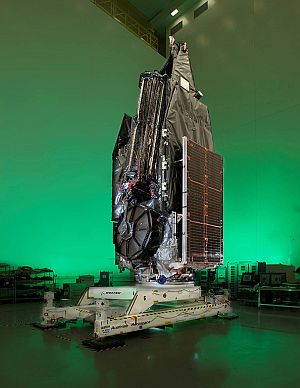The Mexican government will decide this year whether to replace the Centenario satellite it lost to a 2015 Proton rocket failure with a new satellite or replacement capacity on another operator's satellite, according to the Mexican Space Agency.
Francisco Javier Mendieta-Jiménez, director general of the Agencia Espacial Mexicana, or AEM, said June 29 that Mexico is also considering whether to expand the Mexsat constellation beyond the originally planned three satellites.
"We have to have the decision on either the constructor or the service provider, either to continue owning a third and a fourth and a fifth satellite, or to rent capacity on already existing or future launched satellites," Mendieta Jiménez told SpaceNews at the Milsatcom USA conference.
Mexico began the Mexsat system in 2010 with a three-satellite order to Boeing, along with the associated ground infrastructure. The first satellite, called the Bicentenario satellite or Mexsat-3, launched in 2012 on an Ariane 5 rocket. Centenario was supposed to be the second satellite in the constellation, but was destroyed in an anomaly blamed on a weak connection piece between Proton's third stage and a steering engine turbo-pump. The third, Morelos-3, also launched in 2015, but rode an Atlas 5 rocket brokered through Lockheed Martin Commercial Launch Services.
The desire for a Centenario-replacement stems from Mexico's need to ensure a backup for Morelos-3, which is primarily used for defense and national security, as well as emergency response, Mendieta Jiménez said. Centenario and Morelos-3 were identical L-band satellites. Mexico's Bicentennial satellite provides fixed satellite services in C- and Ku-band. Mexsat's civil applications are principally centered on bridging the nation's digital divide by bringing internet access to unreached populaces. Mendieta Jiménez said there are 150,000 communities in Mexico whose sole means of connectivity is by satellite.
Mendieta-Jiménez said that Mexico's current financial situation "is pulling more towards renting capacity," but that doesn't mean canceling long term plans to operate (at least) a third satellite.
"Our position is that the two worlds are not incompatible - we [may] have to rent capacity for short-term needs and also continue developing our fleet of satellites," he said.
Mendieta Jiménez added that new demands for connectivity, particularly from the nascent of Internet things, are driving further development of Mexico's satellite infrastructure.
"We continue our development of the Mexsat system as the requirements increase in bandwidth and in these new things that are operating in the landscape, such as Internet, smart cities, intelligent robotics and others," he said during a conference presentation.
A remote-sensing satellite to boot
Mendieta Jiménez said Mexico wants to operate a remote-sensing satellite in the future, though he did not give a timeline for acquiring one. He said Mexico has already begun the work on the ground system for a remote sensing satellite, and currently obtains Earth-observation imagery from around 20 agencies globally, as well as from companies.
Mendieta Jiménez said Mexico is working with the other members of the Alianza del Pacifico, or Pacific Alliance - Peru, Chile and Colombia - that is part of by sharing on present and future projects "in order to be part of a network of international, high-resolution geospatial programs for Earth observation." Mexico also collaborates with Argentina and Brazil on Earth observation, he said.
Original article


